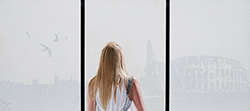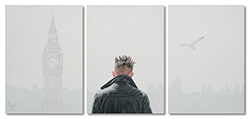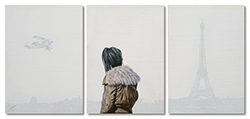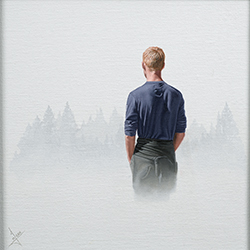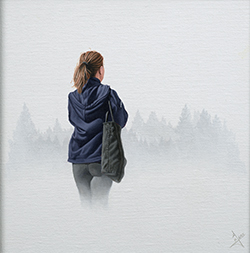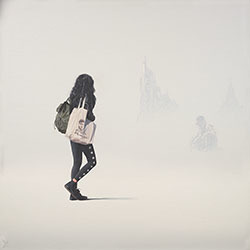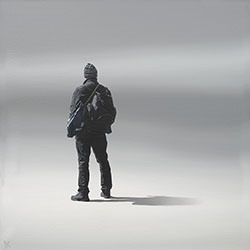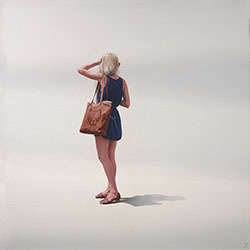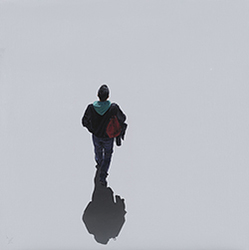| AVAILABLE WORKS | ||||||||||
BIOGRAPHY - Nigel Cox
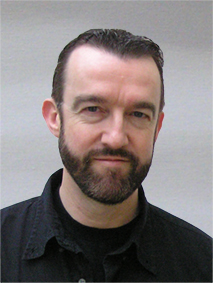
Recalling his home in Dundalk, Ireland, Nigel Cox describes his childhood as a “happy idyll”. Located only a few miles from Northern Ireland, Dundalk is a harbor town on the Irish Sea that today is home to almost 40,000 people. It was somewhat smaller when Cox lived there, but nonetheless a thriving market center where his father was the managing director of a local feed and grain business. The proximity to Northern Ireland—and the Troubles of the late twentieth century—went largely unnoticed by Cox and his three sisters. In fact, he recalls cycling with his friends to a particularly enticing sweet shop just across the border.
The Cox children attended the Dundalk Grammar School, the only protestant school in the area. (It became a multi-faith school in the 1970s.) The curriculum included all of the usual subjects but no courses in art or other creative fields. Cox was particularly interested in math, biology and geography—and of course, sports. His favorites were tennis, badminton, and hockey.
At home, it was Cox’s mother who encouraged a sense of adventure in her children, taking them to places beyond the confines of Dundalk, and exposing them to a variety of foods from other parts of the world. When Cox was twelve years old, the family vacationed in Brittany in northern France, then considered an unusual spot for a holiday. It was also his mother who supported all types of creative activity; she taught everyone how to sew, weave and knit. In addition, she also painted when she could. Although his school did not offer art education, Cox was fond of drawing the superheroes from Marvel comics. Being an artist, however, wasn’t a concept that entered his mind at that point.
After leaving school, Cox left Dundalk for college in Liverpool where he entered a three-year course of study in marine radio and radar electronics. In 1979, he qualified as a marine radio officer in the merchant navy. His first voyage turned out to be the Transglobe Expedition, a polar circumnavigation of the globe roughly along the line of the Greenwich meridian, organized by Sir Ranulph Fiennes and his wife, Ginny. [i] For three years, Cox traveled the world as the radio officer of the Benjamin Bowring, from the South Pacific through the solitary arctic landscapes of the Northwest Passage.
Looking back on his experience now, Cox comments that “it taught me who I was, what I could do.” Not only did he mature over the course of the voyage, but he also fell in love with the empty landscapes that he experienced. Those remain a part of his painting still.
Several years later, Cox was back in Europe and about to embark on a career in shipping. Initially, he signed on for long-distance voyages between Central America, Canada, and Europe on a Chinese banana boat; it involved long months at sea with little time for exploring the ports where they docked. Subsequently, Cox decided to forego the banana trade in favor of an Irish shipping line. He made Amsterdam his home base, traveling during these years around northern Europe, from Scandinavia to Britain and occasionally home to see his family in Dundalk.
All of that changed in the mid-1980s when Cox went to Hamburg, Germany for a weekend and stayed six years. He had met someone during the weekend and decided to take a chance that the relationship would last into the future. And, as he remarks, he felt at home with German culture. It was there that he first began to look more closely at visual art when his mother sent him a small watercolor as a gift. Although it was only 2 inches square, Cox was fascinated by it. When he asked his mother if he could buy another one from the Irish artist, he was disappointed to learn that the little piece was so far out of his price range. That prompted him to go out and buy himself some brushes and watercolors and try to paint something similar himself. A year or so later, Cox exhibited his watercolors under a pseudonym at the May Art Fair organized by his eldest sister Sandra in Dundalk. For the next five or six years, he continued to paint, and eventually to exhibit in Germany, Paris, and Ireland under his pseudonym.
In the late 1980s, Cox’s sister sent him oil paints and canvas for Christmas, a not entirely subtle hint that he might expand his horizons as a painter. For six months, they sat untouched while he tried to pick up the courage to give them a try. Ultimately, he began to create abstract images, familiarizing himself with the oil medium as he painted. Gradually, he began to incorporate surrealistic landscapes into the images before attempting figure painting.
Without any formal art education, Cox followed his own path of studying techniques he learned from books as well as from the artists he most admired. Surrealists such as Yves Tanguy, Max Ernst, and Salvador Dali were early influences as were more realist artists such as the Americans Edward Hopper and Andrew Wyeth. Odd Nerdrum and Francis Bacon provided more contemporary inspiration.
On a trip to London in 1989, Cox met John Sarbutt, the person who would become his lifelong companion. He settled in London and began to work as a graphic artist, utilizing the skills that he’d learned during his years in Germany. When the graphic design firm closed, Cox opened his own firm, Quest Design. Based on the productive relationship he’d established with one of his clients from the defunct firm, Quest Design was hired to do all of the company’s work for two years. That helped to establish Cox’s firm as a reliable and reputable business and ultimately led to considerable growth over the next eighteen years.
For the next decade, Cox focused his attention on Quest Design rather than on his painting. By 2003, however, he found himself somewhat unhappy as a managing director, regardless of how successful the business had become. With John’s encouragement, he started to paint again, and within a year he was offered a solo exhibition at a small London gallery. By 2005, he was participating in group exhibitions and art fairs throughout the UK as well as in France, Italy and New York. In 2007 his first painting was accepted into the prestigious Royal Society of Portrait Painters Annual Exhibition in London. Two years later, in 2009, he closed Quest Design and began to work full-time as an artist.
As Cox gained more confidence in his work, he took on increasingly challenging compositions. One especially gratifying piece was a portrait of the Cuban ballet dancer, Carlos Acosta. After watching him dance at Covent Garden one evening, Cox wrote Acosta a letter asking if he could paint him, assuming that the worst thing that could happen would be that the dancer would say no. To his delight, Acosta agreed to meet for a photo session. In his own words, Cox wrote: “The session started off with my storyboarded ideas for the shoot and then developed into a wonderful collaboration of ideas. Carlos understood where I was heading and would intuitively develop the theme, helping to create some very special poses and shots. It was a wonderful experience and mesmerizing watching Carlos move from pose to pose. It was, at times, like having a personal performance. The power and grace were a heady mix and fed the creative process.” In all, Cox created three paintings of Acosta, one of which was included in the juried exhibition at the Royal Society of Portrait Painters in 2012.
In recent years, Cox has concentrated on paintings of solitary figures, typically with their faces only half seen, if at all, placed against a minimalist backdrop. In a series of three paintings titled Oblivious, he featured a woman absorbed in her shopping expedition, another woman focused on her cell phone, and a young man engaged in texting. All of them fail to see the shadowy helicopters and soldiers behind them. This was an observation on the world we now live in – so connected, yet so oblivious to what’s going on around us, as we go about our daily lives. Following in the tradition of artists as diverse as Edouard Manet and Andy Warhol, Cox offers an image without any overt judgement, while simultaneously requiring contemplation from the viewer.
Cox also ventures into the world of contemporary culture, recently in the context of the post-punk/indie band, Ist Ist. The painter was introduced to the band by his cousin and fell in love with their music; that led to a collaboration on an oil painting titled @ististmusic, from which a limited-edition print was created. In the artist’s words: “It’s wonderful to push the boundaries and to get fired up by the creative talents of others. Music plays a huge part in my painting process . . . as it has throughout my life.”
Janet Whitmore, Ph.D.
[i] For more information about the Transglobe Expedition, see http://transglobe-expedition.org/

